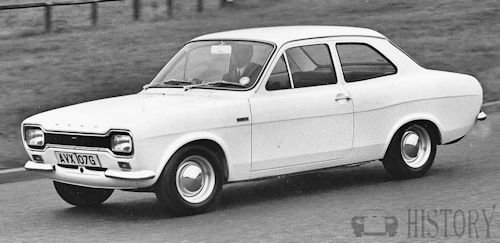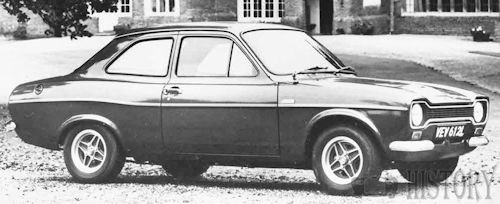Ford Escort Mark 1 RS Twin Cam and RS 1600
 |
|
|
Production |
1968 to 1974 |
|
Assembly |
Halewood & Boreham England UK |
|
Body style |
2-door saloon |
|
Engine |
1,558 cc Lotus Twin Cam 1600 BDA |
|
Wheelbase |
94.5 in (2,400 mm) |
|
Length |
159.25 in (4,045 mm) |
|
Width |
61.8 in (1,570 mm) |
|
Height |
58.5 in (1,486 mm) |
The Ford Escort mk1 RS Twin Cam and RS1600 was a sports car built by Ford for race and road use in the late 1960s to the mid 1970s.
History
The model was initially a higher performance version for rallies and racing built for Group 2 international rallying, produced as the Escort Twin Cam in the regular assembly line in Halewood and completed in a remote corner of the plant. Around 1,100 vehicles were planned to be built there. However, when management realized that for every '49 body a standard Escort and a half was out of stock, production at Halewood was terminated. Further copies were made at Ford Motorsport in Boreham. The RS Twin Cam was built from 1968 to 1971.
The Escort was originally designed without considering the demands of motorsport. However, Ford Motorsport organized an early example and fit-tested the mechanics of the Lotus Cortina over a weekend. The Escort had conventional rear-wheel drive and a four-speed manual gearbox The front axle of this competition car was easy to assemble, as was the rear axle with only minimal modifications. However, the Lotus engine fitted because of its expansive cylinder head with cast-on intake ducts and the voluminous carburettor and air filter system only fitted under the bonnet Its Lotus-made eight-valve twin camshaft head fitted to the 1.5 L non-crossflow block, which had a bigger bore than usual to give a capacity of 1,558 cc and an around 110 hp, when the front end of the engine was shifted a few centimetres to the left (in the direction of travel). So, the engine didn't sit neatly straight in the engine compartment, but was slightly twisted to the left. The battery had to be moved to the trunk to make room for the exhaust. The Escort was also the first small Ford to use rack-and-pinion steering. In order to accommodate the significantly larger transmission of the Cortina, the bulkhead and transmission tunnel were modified accordingly with just use of a two-kilo hammer. Some of the optional accessories exhaust competition manifolds; light-alloy wheels, 6" wide rims; limited slip final drive; heavy-duty front
suspension; adjustable rear telescopic dampers; competition brakes; close ratio 3-speed mechanical gearbox (1st 2.296, 2nd 1.697, 3rd 1.280),and 4.700 5.100 5.500 axle ratios.
Body changes were limited to slightly wider rear fenders to cover the wide rear axle, flared front wheel arches, reinforcement plates on the strut mounts and the modified transmission tunnel for the Cortina 2000E gearbox. Such bodies ran in production as "Type 49" and had chassis numbers that began with "49”. With wider 5.5j 13" steel deep dish wheels similar to the lotus Cortina these later became vented on the Rs 1600 and only a small round badge at the rear and badges on the wings the look was still very similar to the normal mk1 escort. More designs came on the later AVO RS range of cars. The car could reach 115mph.
PERFORMANCE: Ford Escort RS Twin Cam
- engine capacity 95.07 cu in, 1,558 cu cm
- fuel consumption 23.6 m/imp gal, 19.6 m/US gal
- max speed 115 mph, 185 km/h
- max power (SAE): 115 hp at 6,000 rpm
- max torque (SAE): 106 1b ft, 14.6 kg m at 4,500 rpm
- max engine rpm: 6,600
- specific power: 73.8 hp/l
- power-weight ratio: 15 lb/hp, 6.8 kg/hp
- acceleration: standing 1/4 mile 17.2 sec, 0—50 mph (0—80 km/h) 7.2 sec
- max speeds: 39.5 mph, 63.6 km/h in 1st gear; 58 mph, 93.4 km/h
- in 2nd gear; 84 mph, 135.2 km/h in 3rd gear; 115 mph, 185 km/h in 4th gear
Production of the Twin Cam, was phased out as the RS1600 was to be developed around just over 800 of the planned 1000 being built.
The Lotus engine gradually proved to be no longer powerful enough and also not particularly reliable in sports use, as well as being complex and expensive to maintain. That's why Cosworth became tasked with designing a new four-valve cylinder head for the existing block. The resulting BDA engine replaced the Lotus four-cylinder in the otherwise unchanged vehicle, which was then marketed as the Escort RS 1600. The RS1600 used a Kent engine block with a 16-valve Cosworth cylinder head.
RS1600 were built at the AVO Plant Ford's (Advanced Vehicle Operations facility at the Aveley in South Essex UK. These models featured more strengthened bodyshells with more options.
The BDA engine was also installed askew in the engine compartment, although this was no longer necessary because of its considerably slimmer dimensions. Taking advantage of all production and repair tolerances, the BDA had 1601 cm³ and was therefore allowed to be enlarged to a displacement of up to two litres in sport. A few hundred examples of the RS1600 were built in Boreham. With the existing cast iron block, however, no more than 1835 cm³ could be realized. The external tuner Without Ford's knowledge, Brian Hart had designed an aluminium engine block on his own that could replace the gray cast iron block and offered the possibility of realizing a displacement of two litres.
The sports specimens had a displacement of two litres and rear axles with four trailing arms (the top two pointing backwards), a Panhard rod and coil springs. With such vehicles, The Ford works team was practically unbeatable in the late 1960s and early 1970s, the Ford team with drivers such as Roger Clark, Timo Mäkinen and Hannu Mikkola was able to achieve numerous successes in rallying.
Ford made all the works team's developments generally available through its well-developed RS dealer network, especially in Great Britain, as soon as they proved to be useful and stable. In this way, each team, assuming the appropriate financial strength, could prepare vehicles to factory standards. As a result, Ford was often defeated by private teams in competitions, but this was not a bad thing for marketing reasons. This made Escort RS very popular competition vehicles in Great Britain. There was the phrase that every weekend somewhere in the UK there is some event that is won with an escort.

Ford Escort RS1600
Technical
-
Ford Escort RS Twin Cam RS 1600 Technical details and specifications (1968-1974)
Ford Escort RS Twin Cam
ENGINE
location front, 4 stroke
cylinders: 4, vertical, in line
bore and stroke: 3.25 x 2.87 in, 82.5 x 72.9 mm
engine capacity: 95.07 cu in, 1,558 cu cm
compression ratio: 9.5
cylinder block: cast iron
cylinder head: cast iron
crankshaft bearings: 5
valves: 2 per cylinder, rotary or vane-type pump, full now filter
carburation: 2 Weber 40 DCOE horizontal twin barrel carburettors
fuel feed: mechanical pump
cooling system: water
TRANSMISSION
driving wheels: rear
clutch: single dry plate (diaphragm);
gearbox: mechanical; gears: 4 + reverse
synchromesh gears: all
gear-box ratios: 1st 2.972, 2nd 2.010, 3rd 1.397, 4th 1, rev 3.324
gear lever location: central
final drive: hypoid bevel
axle ratio: 3.777.CHASSIS
type integral
front suspension: independent, by McPherson, coil springs telescopic damper struts, anti-roll bar
rear suspension: rigid axle: semi-elliptic leafsprings, trailing radius arms, telescopic dampers.STEERING
rack-and-pinion
turns of steering wheel lock to lock: 3.50.
turning circle (between walls): 29.7 ft, 9.1 mBRAKES
front disc (diameter 9.25 in, 235 mm)
rear drum, servo
area rubbed by linings: front 190 sq in, 1,225.50 sq cm
area rubbed by linings: rear 96 sq in, 619.20 sq cm
area rubbed by linings: total 286 sq in, 1,844.70 sq cm.ELECTRICAL EQUIPMENT
voltage: 12 V
battery: 38 Ah
generator type: dynamo, 264 W
ignition distributor: AutoliteDIMENSIONS AND WEIGHT
wheel base: 94.50 in, 2,400 mm
front track: 49 in, 1,245 mm
rear track: 50 in, 1,270 mm
overall length: 160.80 in, 4,084 mm
overall width: 61.80 in, 1,570 mm
overall height: 53 in, 1,346 mm
ground clearance: 5.80 in, 147 mm
dry weight: 1,730 1b, 785 kg
distribution of weight: 51.6% front axle, 48.4% rear axle© Motor car History
Service
-
Ford Escort RS Twin Cam RS 1600 Maintenance and Service Guide (1968-1974)
Ford Escort RS Twin Cam
Fuel type: 100 oct petrol
Engine oil change: 7.20 imp pt, 8.67 US pt, 4.1 1, SAE 1OW-30, change every 2,500 miles, 4,000 km
Lubricating system total capacity: 7.80 imp pt, 9.30 US pt. 4.4 1
Cooling system capacity: 11.60 imp pt, 13.95 US pt
Gearbox oil: 1.75 imp pt, 2.11 US pt, 1 1, SAE 80, no change recommended
Final drive oil: 2.60 imp pt, 3.17 US pt, 1.5 1, SAE 90, no change recommended
Greasing: none
Tappet clearances: inlet 0.005-0.006 in, 0.13-0.15 mm, exhaust 0.006-0.007 in, 0.15-0.18 mm
Valve timing: inlet opens 26° before tdc and closes 66° after bdc, exhaust opens 66° before bdc and closes 26° after tdc
Normal tyre pressure: front 24 psi, 1.7 atm, rear 24 psi, 1.7 atm.
Width of rims: 5.5"
Tyres: 165 x 13
Fuel tank capacity: 9 imp gal, 10.8 US gal.
Carrying capacity: 882 1b, 400 kg© Motor car History
Manuals
Media
Ford Escort MkI RS Twin Cam #Shorts
Author Motor car History Duration 00:54-
Ford (europe) Previous 41 / 128 Next
